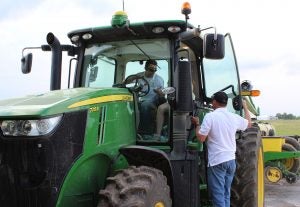U.S. farmers, ranchers, and producers are steadily growing older. Nearly 1.3 million farmers are now at or past the age of retirement. Meanwhile, just 300,000 farmers are under the age of 35.
The average age of farmers increased from 56.3 to 57.5 between 2012 and 2017, and according to the 2022 Census of Agriculture data, it has increased to 58.1 years of age. And, those farmers have been at it for a while — the average length of time on the job was 23.4 years.
“This survey, in addition to all the amazing work and data that it contains, is a wake-up call,” said U.S. Agriculture Secretary Tom Vilsack at an event for the census release on Tuesday.
As legacy producers retire, it’s no secret that the U.S. needs the next generation to take on the critical business of providing food, feed, fuel, and fiber to a growing population.
According to the latest census data from the U.S. Department of Agriculture, the number of beginning farmers has continued to rise, with those who have farmed for 10 or fewer years increasing to over 1 million beginning producers. Producers under the age of 35 also increased slightly, from 290,000 to 300,000 between 2017 and 2022.
Those who are newer to farming account for 1 million of the 3.4 million producers counted in 2022, with an average age of 47.1. Their farms were smaller than average in both acreage and sales.
Meanwhile, the number of producers between the ages of 35 and 64 declined 9 percent, while the number of producers 65 and over increased by 12 percent continuing to contribute to the aging producer population.
Rhode Island topped the list with the largest percentage of beginning farmers (41.4%), followed by Alaska (38.7%) and Maine (35.9%).
There was also an increase in the number of operators aged 44 and younger who are involved in day-to-day decision-making.

While the number of young farmers is increasing, the increasing age of farmers indicates that the number of young farmers is not keeping pace with the aging out in the field.
Family farms still account for 95 percent (down a percentage point since 2017) of all U.S. farms, operating 84 percent of land in farms. However, as the USDA points out, inheriting family farms likely comes with increased pressure for young producers to succeed.
Young people face the uphill battle of establishing themselves in agriculture with increasing land prices, decreased land access, rising interest rates, and labor challenges. As the years go by, farms get bigger. In 2022, the average size of farms increased by 5 percent, while the number of farmland acres decreased by 2 percent.
That consolidation is apparent in the difference between the decline in every size farm, except for the largest farms with 5,000 or more acres.
“We’re just becoming more efficient,” said Brad Summa, director of the Heartland Regional Field Office of the USDA’s National Agricultural Statistics Service. “But that efficiency comes at a cost. To be a really big, large, producing farm, there’s a lot of overhead. And it’s tough to break into that if you are a new and beginning farmer.”
Meanwhile, according to the USDA, less than $0.15 of every food dollar spent at the grocery store ends up with the farmer. By the time farmers pay for the production of their product, they get about $0.07.
Vilsack points to a hope that researchers, statisticians, and policymakers will take this data and send a message of hope to young farmers, while creating and adapting a different model for the farming industry.
“One that acknowledges and recognizes the importance of production agriculture, and certainly acknowledges the significant investment people have made in very large farming operations,” said Vilsack during Tuesday’s news conference. “But one that also sends a message of hope and opportunity out to small and mid-size operators by giving them multiple sources of revenue into the farm and not requiring them to work a second full-time job essentially.”



